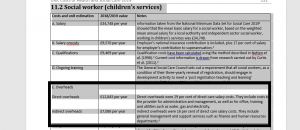April 23, 2020
Lesley Curtis
Even though local authorities have overspent on children’s social care services, it seems that the increase in spending has not kept pace with demand. There are also signs that the quality of service has declined over the past decade (Institute for Government, 2019). With this in mind and in setting out its plans for improving the quality of children’s social care services in England, the Department for Education published its Vision for Children’s Social Care in 2016. One of the points made was that ‘central government, local authorities, and other public sector organisations need to know their unit costs and how these costs compare to help them make the best decisions about services and to manage successfully in the current budgetary climate’ (p.38).
This is where the Unit Costs of Health and Social Care can assist government and other public sector organisations. Our 2019 edition has just been published and the chapters of interest for children’s social care providers and commissioners are 6, 8 and 11. In July 2018, our blog Unit Costs: The Last Chapter focussed on section V and the type of information you can find there. Readers may notice that this year, there are some changes in section V, chapter 18. The cost of qualifying social workers has more than halved! Our preface discusses why this is the case in more detail, but in short, a recent analysis of the Labour Force Survey has revealed that the expected working life of a social worker has increased by eleven years since the survey was last carried out in 2008, possibly as a result of councils encouraging and supporting experienced professionals back into employment. With a longer expected working life, annualised costs are reduced; in this case from £25,417 in 2018 to under £9,500 in 2019.
Section 6, our chapter on services for children and their families contains the unit costs of care homes, foster care and adoption, mainly constructed using the most recent section 251 return (see last year’s blog ‘new and innovative children’s services in UCR 2018’ for the full list). Most of our work is drawn from studies and secondary sources of data and sometimes we are fortunate that local authorities or third sector organisations make contact with us to ask for our help in estimating their unit costs. The advocacy for children with additional/multiple needs and counselling for children with mental or emotional difficulties schemas are good examples of where this has happened. The problem with research and occasional survey sources however is that they get outdated as practice changes and we have a rule that if information sources are more than ten years old, they should be replaced or withdrawn from the volume as they may no longer be representative.
This brings me to where we now need the help of local authorities.
You will see from the children’s social care schema found in chapter 6 of the UCH&SC that the sources we have used to estimate overheads has just reached this ten year deadline. The snippet below highlights the breakdown of information we need to calculate the direct and indirect overhead percentages. Even though it is unlikely that overheads have changed so radically as to affect the unit cost of a children’s social worker significantly, they do span the ‘austerity’ period and our goal is always to keep our estimates as current as possible.
We would therefore be grateful if you have any information which might help us to update this work. Alternatively, if any local authorities are willing to work with us to update this information please could you contact either me l.a.curtis@kent.ac.uk or Amanda Burns a.l.burns@kent.ac.uk
Finally, every year we commission new articles which, following publication in our volume, are stored in our online database. Our earlier blog gives more information. This has been very successful, with nearly 1,500 visitors last year. Of course if you have any ideas for an article or guest editorial on children’s social care, please let us know.
This study/project is funded by the National Institute for Health Research (NIHR) [Policy Research Programme, Unit Costs of Health and Social Care, 035/0093.]. The views expressed are those of the authors and not necessarily those of the NIHR or the Department of Health and Social Care.
